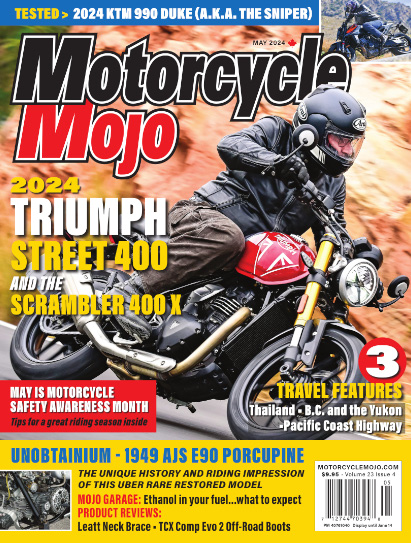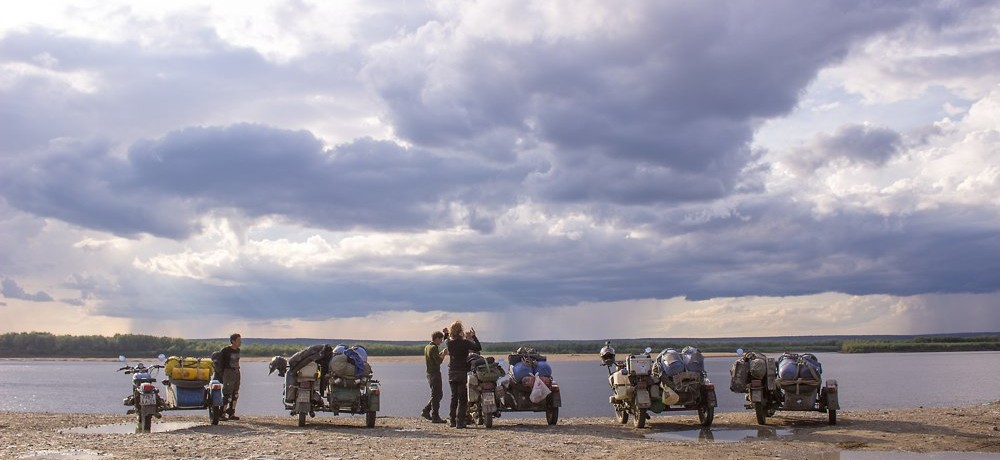Sometimes we need to step outside the box to find our way
As some of you know, the Mojo staff migrates around the country throughout the motorcycle show season. During this time, we get to meet with a lot of incredible people undertaking remarkable challenges. Many of their stories have made it into the magazine over the years, and so this gypsy lifestyle we temporarily endure, in many ways fuels our magazine and our creativity. On a personal level, I’ve always found inspiration and motivation from this time away from home. And I’m not alone.
During the 2015 Vancouver Motorcycle Show, I met a group of people travelling from Germany by motorcycle who also sought inspiration on the road. They had departed from Halle (Saale), in late summer 2014, ridden east across Europe, then through Kazakhstan, Mongolia and Russia. Their ultimate goal is to cross North America and end in New York.
Sounds Simple Enough

While sitting with Efy, Kaupo, Anne, Johannes and Elisabeth, I listened intently to their story, each one picking up where the other’s sentence left off, and never speaking over one another.
They explained their motorcycles for this expedition were a pack of 1980s Russian-made Ural 650 sidecar rigs, each named by the group to match its unique peculiarities. A strategic choice, given they’d be travelling across Mongolia and Russia, where spares should be easy to find, along with help, as they had very limited mechanical knowledge – at least at the start, that is. In fact, most had just gotten their motorcycle licences at the time of departure.
The trip was planned in stages. Part one of the journey had taken them 5000 km east through Austria, Hungary, Serbia, Bulgaria, Greece, Turkey and then up to the Georgian Republic. It was there, near the Georgian settlement of Tserovani, that they made their first winter camp in late November 2014. Their progress to that point was not what you’d call rapid, more like an exploratory pace.
Misplaced Identity

The more they told me about their travels and the inspirations for them, the more ironic the missing fingerprints became. You see, this group had met through university and are all artists in their own right. They’re a collection of young, creative, energetic and extremely motivated people. I’ll tell you now that they’re also very intelligent, because you may not believe me after you read about their future intentions.
By embarking on this trip, they never intended on leaving their professions behind; rather, they planned to make the world their studio. They would do it as a group, depending on each other, learning skills along the way and experiencing life without the bubble wrap and safety warnings that are strangling their generation. If something needed saying, it was done face to face; if a problem arose among the group, there was nowhere to hide from it, no text message or social media to mask their true feelings. Their individuality, like their fingerprints, faded slightly as the well-being of the group took precedence. Nowhere was that more evident than on the second leg of their journey.
Not So Fast

After leaving Georgia in March 2015, they had in fact made it to Russia, travelled across Kazakhstan and Mongolia, then back into Russia and Siberia. The last portion of this second stage would take them to far eastern Russia, but that meant they’d have to traverse an original, unused portion of the Road of Bones, now known as the Old Summer Road. This route has not been maintained for 20 years and, as some very famous motorcycle travellers have discovered in recent years, it’s almost impassable, even with the finest adventure bikes and a support team. The vast majority of the land here is covered with rivers, streams, bogs, marshes and all manor of unfriendly motorcycle terrain. To complicate matters, this group is travelling with four Urals, each weighing in at around 400 kg, and did I mention, most of the bridges have long ago crumbled or have had their materials repurposed by enterprising locals? In some cases they would spend a day draining the fluids from the motorcycles, unloading them, then constructing a pulley system and dragging the bikes across the river. After the feat had been accomplished, the Urals were put back together, drained of water and the previously removed vital fluids poured back in. Each time their reward was the uncertainty that the bikes would start again.
For the smaller crossings, they’d wade into the water to find a spot to cross. When that wasn’t an option, they’d use their most beloved accessory, a chainsaw, to fell trees and make a bridge. They inched their way across eastern Russia as winter approached.
With all their challenges came the opportunity to experience the kindness of people they met along their path. They told me repeatedly how kind the Russian people had been, giving without asking for payment, offering assistance wherever they went.
The Next Stage
This was the point in the story when they revealed to me the plan for the upcoming third stage. After they had reached the east coast of Russia, they shipped their bikes to Vancouver, where they were spending the 2015-16 winter with friends, raising funds and sponsors. But they weren’t planning to next ride on to New York; they were instead planning to develop a pontoon system that will be attached to each Ural, complete with a propeller system powered by the bike’s driveshaft.
With this, they plan to return to Russia, put the Urals on the floats and glide 1600 km up the Kolyma River (you have to look at this on a map to appreciate the undertaking), almost to the East Siberian Sea. After that minor feat, they’ll be heading east again to what was once the land bridge that connected two vast continents and the path that many believe was the route along which humanity travelled to populate this continent. Only now it’s not a land bridge – it’s the Bering Strait.
Hope Floats
At the time of this writing, the group is preparing to test a floating Ural on the Frasier River in B.C. and intend on proceeding with their plan as soon as possible, so as to take advantage of the little bit of good weather in northeastern Russia.
When they return to North America the second time, it will be after having traversed the notorious waters of the Bering Strait aboard their Urals and, hopefully, arriving safely in Alaska. Only then will they continue on to New York – which should be no more than a walk in Central Park compared with their previous adventures.
Never Inside the Box
I still shake my head at the thought of this group, not out of sympathy or because I think they’ve lost their minds, but out of wonder and envy.
The name of their expedition, leavinghomefunktion, is a perfect form of irony: the “Leaving Home Funktion” is a German term for a feature found on many modern automobiles. It turns the vehicle’s lights on when you push the unlock button on your key fob to help you find your way to the car in the dark. A guiding light, so to speak, to prevent us from getting lost or, God forbid, fall on our faces while walking the 10 metres from the house to the steel box in our driveway. Thankfully, there are people – young people – who want to blaze their own trail, free of technological nannies, superficiality and the societally imposed norms. They want to experience life head on and have no interest in remaining inside the safe and familiar box.
These few pages can’t do justice to the scope of their adventure, so I recommend you take a look at their website leavinghomefunktion.com, where you’ll find all the details as well as a blog with incredible images and insights. They also have a YouTube channel, a book in the works and possibly a documentary.
Who knows what else could come from an adventure as grand as this?




































